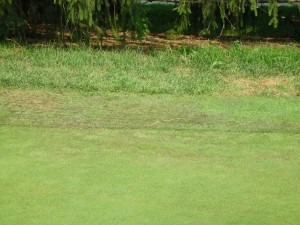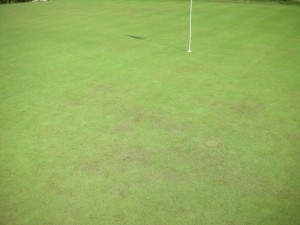The temperature dial is getting turned up, and summer stress is on the way. Unfortunately summer is often when we are sometimes pushing greens even further with low mowing heights for tournaments, etc.
Over the past few years, Rutgers University has led a multi-university research program to investigate the impact of cultural practices and fungicides on turfgrass anthracnose, including fertility (it’s really important!), mowing height (even a small increase can help!), and more.
We have some more information about anthracnose (including fungicide info) HERE.
The BMP’s from Rutgers are outlined HERE.
If you just can’t get enough, details from Rutgers are available HERE (you can click through a 54 page pdf with lots of images and data)
Here is a cheat-sheet of some tidbits from the above links about agronomic practices and anthracnose:
Fertility program: Provide adequate nitrogen to maintain turfgrass growth. Low nitrogen can increase anthracnose severity. Applications of soluble N at 0.20 to 0.25 lb N/1000 square feet every two weeks is beneficial. Apply adequate potassium.
Mowing and rolling: Low mowing heights can raise the risk of anthracnose development. Slight increases in mowing height can reduce disease pressure. Consider raising the mowing height to 3.6 mm (0.14 inches). Rolling on alternate days will increase ball roll and can slightly reduce anthracnose severity.
Irrigation and drainage: Anthracnose can be more severe with either too much or too little water. Irrigate to supply 60-80% of evapotranspiration. Avoid wilt stress. Hand-water when practical. Anthracnose tends to be more severe on putting greens with poor air movement and poor drainage. Don’t overwater putting greens: excessive soil moisture may damage roots and decrease photosynthesis, predisposing it to anthracnose injury. Aerify in the fall to improve drainage, and improve airflow to the site.
Topdressing: Light, frequent topdressing reduces the overall risk of anthracnose.
Foot traffic: In one of the more recent Rutgers studies (link to article HERE by Joseph Roberts and James Murphy), they looked at foot traffic + sand topdressing, foot traffic – sand topdressing, no foot traffic + sand topdressing, and no foot traffic and no sand topdressing. The combination of foot traffic + sand topdressing had the LEAST amount of disease.
Plant Growth Regulators: Normal use of trinexapac ethyl and ethephon has reduced anthracnose in trials. Mefluidide has had little effect in most cases.
Cultivation: Shallow verticutting (0.13 inch) has had mixed results, leading to slight increases in disease in some studies and no effect in others. If anthracnose is active, use fungicides before any cultivation.


